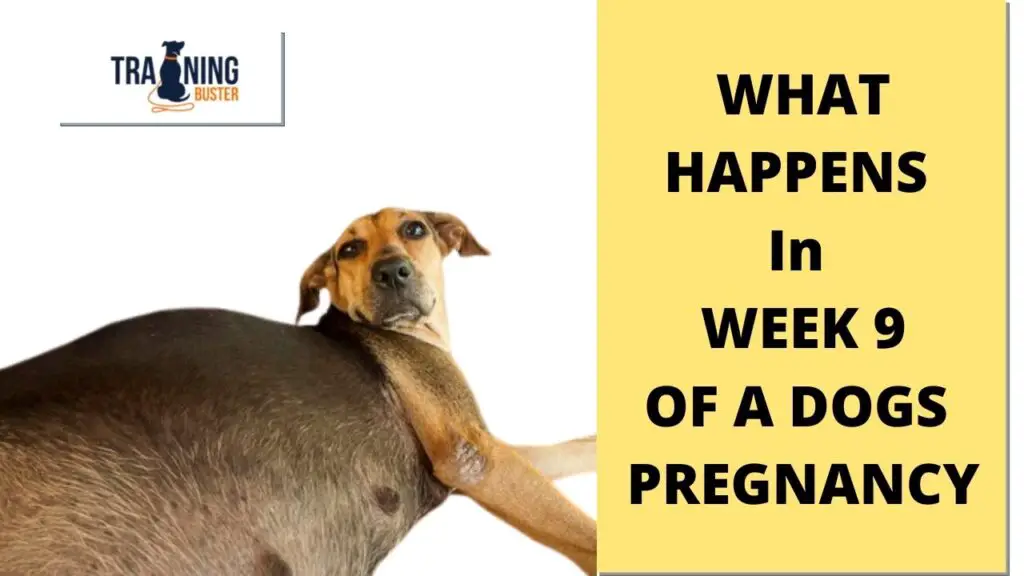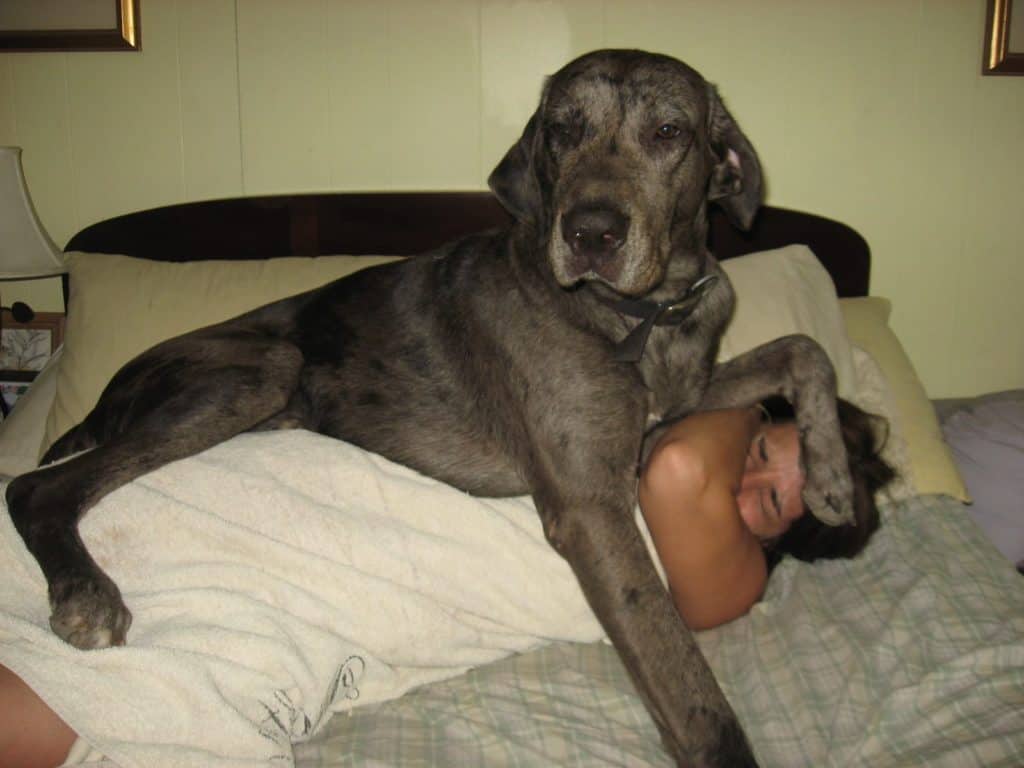
So, it’s the last week of your dog’s pregnancy! Your dog will be giving birth any day now! In this group of articles, we’ve been detailing what happens throughout a dog’s pregnancy, from the first week to the last.
And now, it’s time to find out what happens in week 9 of a dog’s pregnancy. Let’s find out what stage the puppies are at, and how you can assist your dog when they give birth.
What happens in the last week of dog pregnancy?
Now that it’s the last week of your pooch’s pregnancy, they’re going to be pretty tired. Their size and reduced energy will make it difficult for your pooch to move around much, so your dog will probably spend most of their time lying in their whelping box or nest. They may want to spend more time alone, and might not appreciate attention.
Later on in the week, you may see your pooch scrabbling constantly at their bedding, as though they are trying to make themselves comfortable, or prepare for the pups. They may also lose interest in eating. These are all sure signs that labor is near.
Do puppies move a lot before birth?
Yes. As fetuses, your dog’s puppies actually first began moving around at around 5 to 7 weeks old. At this point, the puppies were fairly developed, with faint and tiny but present heartbeats. At that point, the puppy fetuses were just 45 mm long, or the size of a golf ball.
What’s more is, the closer they get to the delivery date, the more the puppies will begin to move. In fact, by the time the puppies are 8 weeks old, you won’t even need to feel for the puppies’ movement.
Instead, you’ll actually be able to see the fetuses moving around! This is partially due to the fact that your dog will lose some belly fur in their 8th week of pregnancy, so that the puppies can more easily find where to feed.
What are signs a dog is going into labor?
A while before your dog shows any other signs of going into labor, their temperature will decrease from around 101°F or 38.3°C to as low as 97°F or 36.1°C. This is where it comes in handy for you to measure your dog’s rectal temperature often.
Your dog’s temperature could drop as early as 12 to 24 hours before their labor actually begins. So, taking their temperature regularly gives you plenty of time to prepare!
Later on, your dog may become anxious or restless just ahead of giving birth. They may pace back and forth, panting. They may also seem uncomfortable, lying down then getting up again. Your dog will also probably refuse water and food, too.
When labor actually begins, you may notice a green plug that comes out of your dog’s vulva. This plug will either fall on the floor, or get stuck in your dog’s fur. Your dog’s waters will also break just before birth begins. Your dog may want to drink this liquid, and this is okay.
How can I prepare for my dog to give birth?
Since your dog will be giving birth any day now, it’s super important to have everything ready! First of all, there are tools and other items to buy and have at hand. If you will be delivering your dog’s puppies, you will need a few surgical tools.
Rubber gloves, for example, will keep you mess-free and hygienic as you pull out puppy after puppy, while some blunt scissors and something to tie the umbilical cord off with will also come in handy.
When all the puppies are born, a feeding bottle will help you nourish them, while a rectal thermometer will help you keep track of your dog’s temperature and get a sense of when labor is ending.
Items like antiseptic wipes, and Iodine may also be useful. Once you’ve acquired it all, it’s a good idea to layout your birthing kit near your dog’s whelping box. This will help you keep track of it, and should provide convenient access during the birth. Have equipment like the scissors sterilized ahead of time.
How can I help my dog give birth?
Delivering your dog’s puppies at home is a rewarding, yet challenging thing to do. But, provided you are prepared, everything should go smoothly enough. Long before your dog gives birth, you should get in contact with your vet. Your vet will advise you on what type of birth is best for your dog, and whether a Cesarean is necessary.
Your vet should also give you plenty of advice on how to assist your dog as they give birth at home, and when you should contact them.
As soon as you spot that drop in your pooch’s temperature, or another sign that labor is imminent, it’s go time! First of all, make sure the temperature of the room is about 80°F, or 27°C. You could use air conditioning, warm blankets, or a pet’s heating pad. Then, line your dog’s whelping box with clean, fresh blankets, rags, or a disposable lining.
Though their temperature may have dropped, your dog could keep scratching at their bed, refusing food, or even vomiting for 6 to 12 hours before their cervix finally dilates.
So, just concentrate on keeping your pooch comfortable during this time. Pet them, insofar as this is comfortable for them, and keep them warm. Offer some water and tasty foods, but don’t force your dog.
When your pregnant dog is finally ready to give birth, they’ll begin obviously straining. This could take anywhere from 10 to 30 minutes with each pup.
You’ll see a membrane around each puppy as they are born. You’ll need to make sure that this membrane is removed so that the puppy can breathe. Fortunately, your dog will probably instinctively break this membrane by quickly licking and biting at the area around the puppies’ mouths.
They may also instinctively bite through the umbilical cord, too. But, you may need to step in as your dog gets tired, or if they are too slow.
If you need to remove the membrane, peel it off gently, using your fingers. Then, rub the pup clean using a towel or blanket. After this, you’ll need to tie the umbilical cord around half an inch from the puppy’s belly, and cut it with sterilized scissors.
If your dog wants to eat the placenta, do allow them to eat one or two. But, restrict them from eating all the placentas, as this may cause vomiting.
With so many puppies to deliver, your dog may also take a break at any point. This break could last anywhere from 45 minutes to 4 hours. This is no cause for concern, unless more than 4 hours pass.
When should I be worried?
As you can see, your dog pretty much instinctively knows exactly what to do when it comes to giving birth. However, there are some things you should look out for as your pooch gives birth.
For example, we previously mentioned how your dog will probably go into labor within 24 hours of her temperature decreasing. But, if your dog does not begin to give birth within 24 hours of their temperature dropping, this may be cause for concern.
Equally, if your dog does go into labor, but strains or has contractions for over 45 minutes, this is another reason to get into contact with your vet.
As well as this, if a pup seems to be stuck in the birth canal, is stuck halfway out, or your dog is too tired to push the puppy out, get in touch with your vet right away.
Other signs of complications include your dog seeming to be in extreme pain, their gestational period exceeding 70 days, or as we mentioned, more than 4 hours elapsing between births.
Even if nothing seems too wrong, contact your vet if you are worried at all.
Check out every week of a dogs pregnancy below
- What happens in week 1 of a dog’s pregnancy
- What happens in week 2 of a dog’s pregnancy
- What happens in week 3 of a dog’s pregnancy
- What happens in week 4 of a dog’s pregnancy
- What happens in week 5 of a dog’s pregnancy
- What happens in week 6 of a dog’s pregnancy
- What happens in week 7 of a dog’s pregnancy
- What happens in week 8 of a dog’s pregnancy
- What happens in week 9 of a dog’s pregnancy


